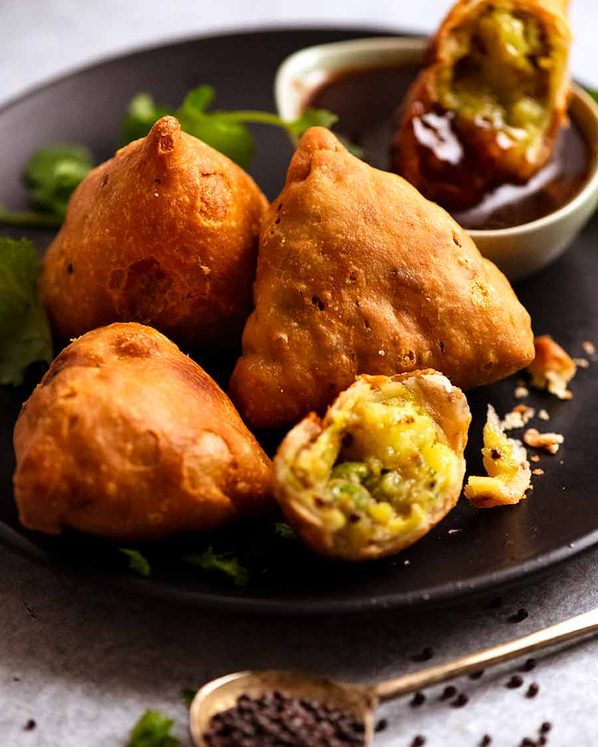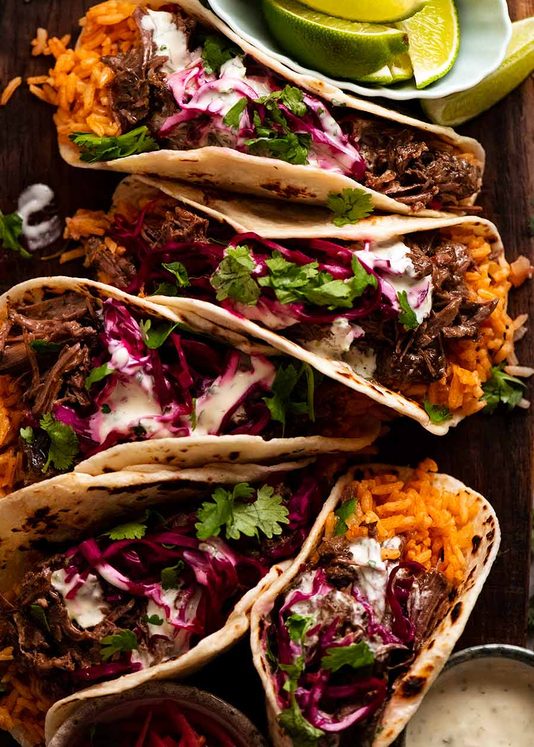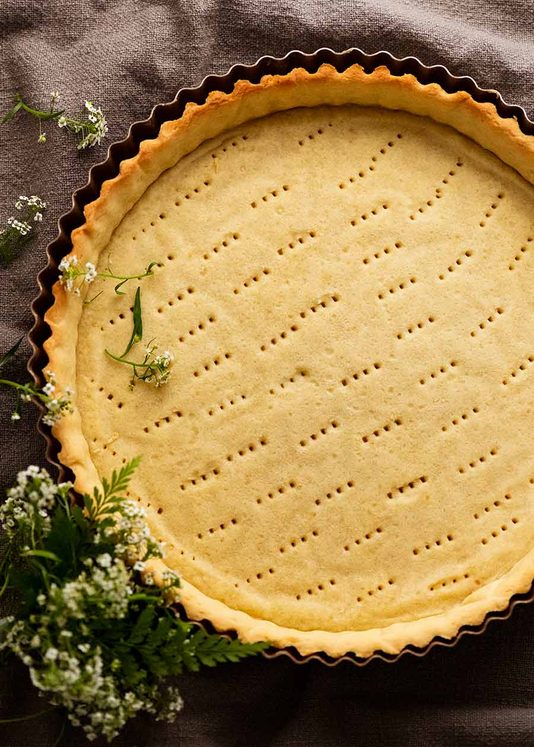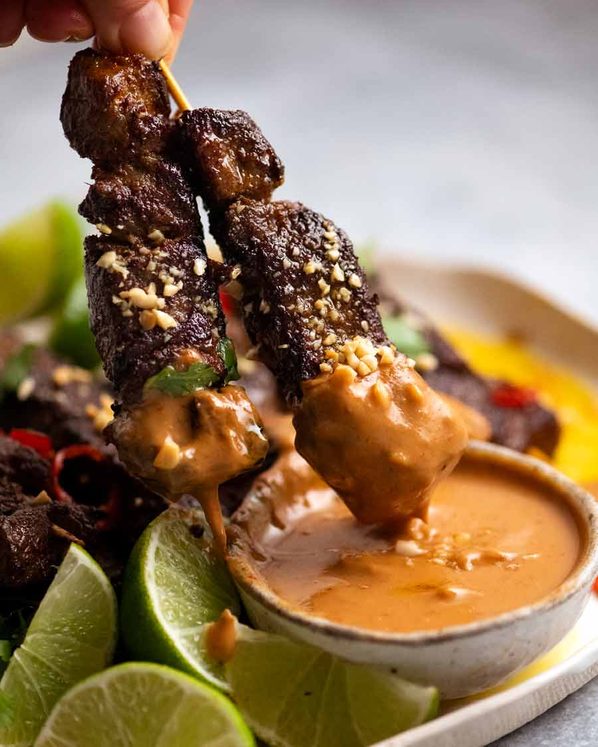Nobody can resist these perfect pyramids of flaky pastry, stuffed with a delicious spiced potato filling! But not all samosas are created equal. Too dry, not enough filling, bad pastry, weak spicing….. So I set out to make my own, and am proud to now share with you my very own Samosa recipe – my idea of the perfect Samosa!
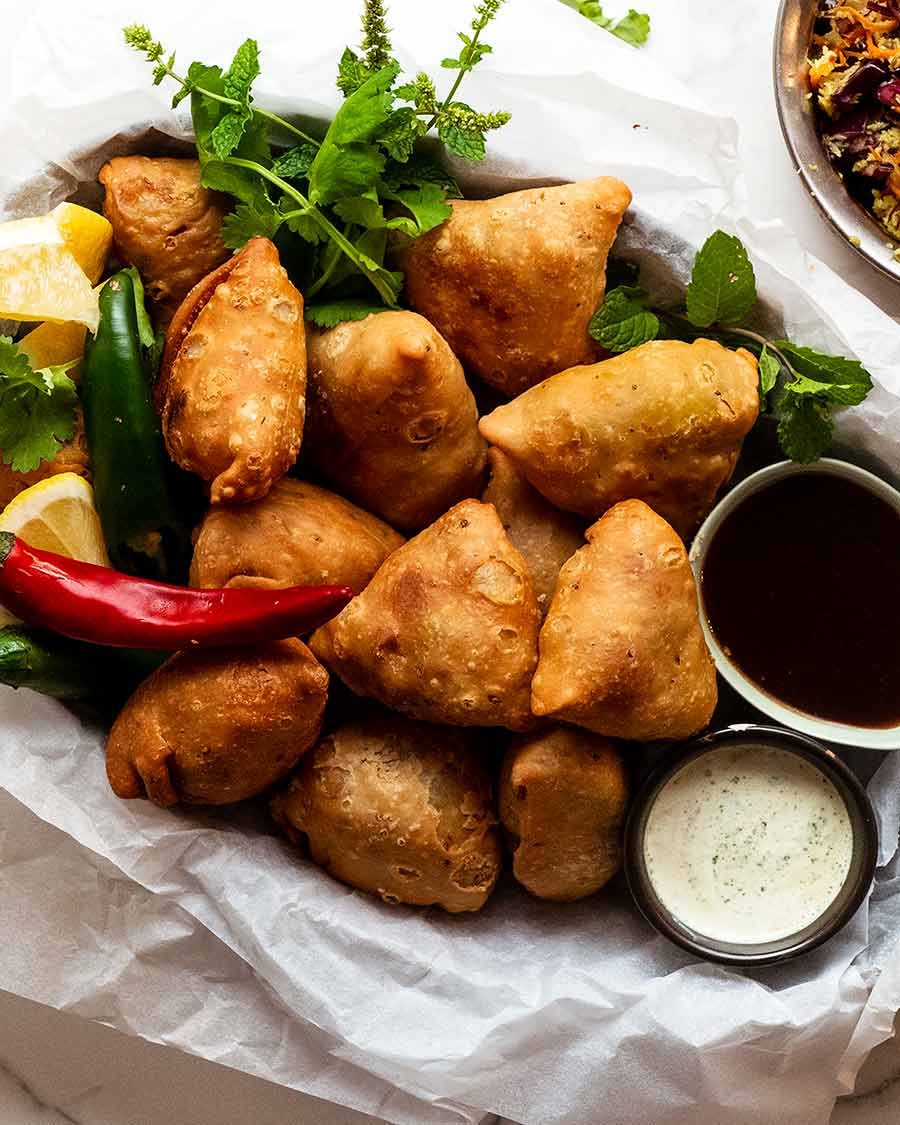
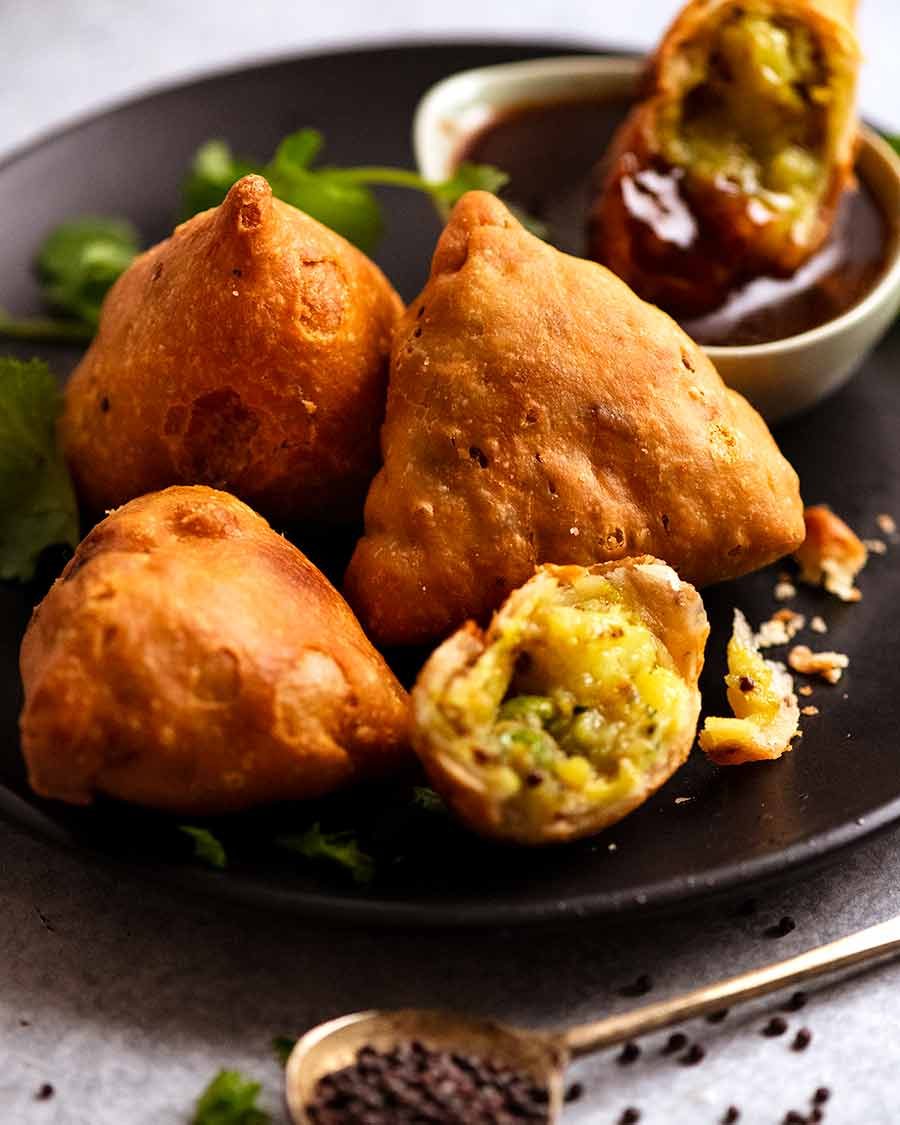
🌶 Welcome back to Indian Week! 🌶
It’s Indian Week here at RecipeTin Eats! And week where I’m sharing 4 brand new Indian recipes so you can make your very own feast at home:
-
Palak Paneer – the famous Indian Spinach Curry, complete with homemade fresh cheese curd (it’s so easy!);
-
Naan – the fluffiest, bubbliest, chewiest naan you’ll ever make at home, a recipe that eluded me for 5 years!
-
Thoran-style Cabbage Carrot Salad – quite possibly the most incredible cabbage salad you will ever have in your life;
-
Samosas – this recipe!
-
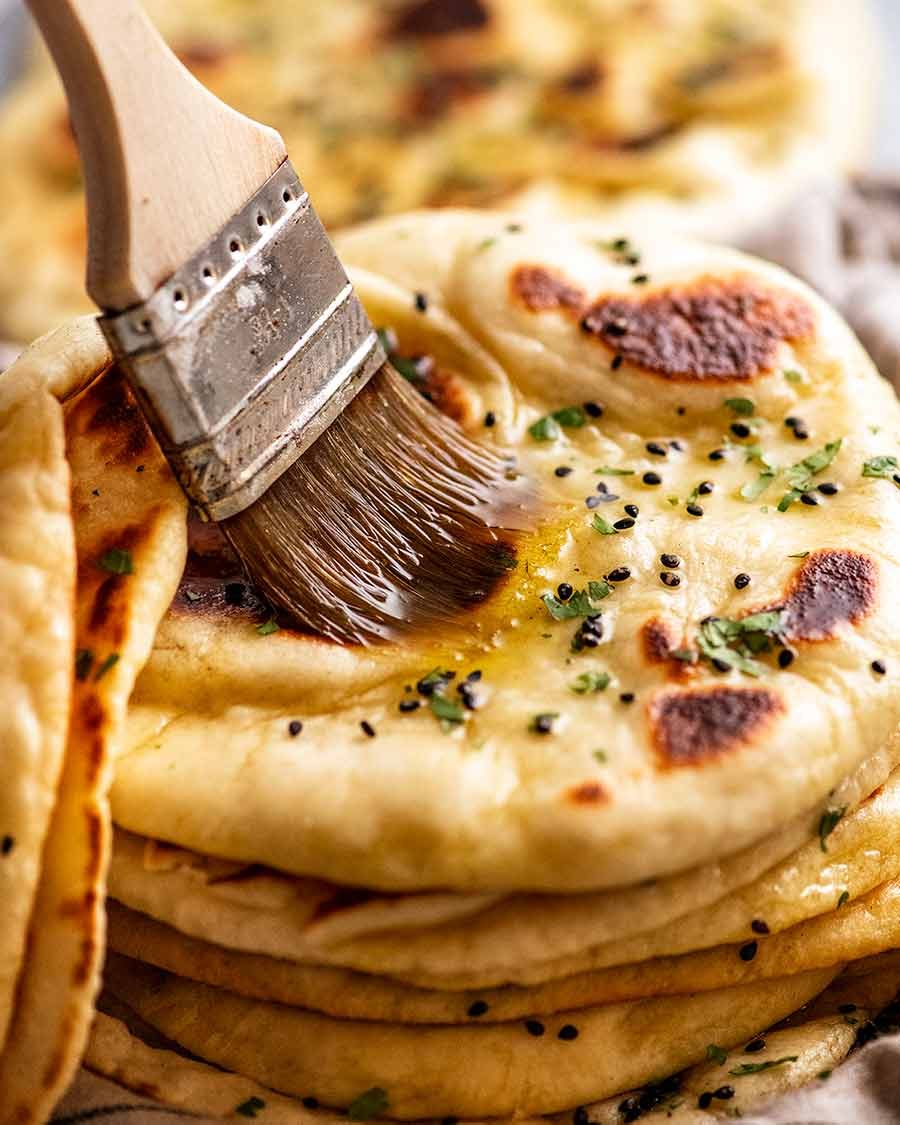
Homemade Naan – incredibly fluffy, bubbly & chewy! -
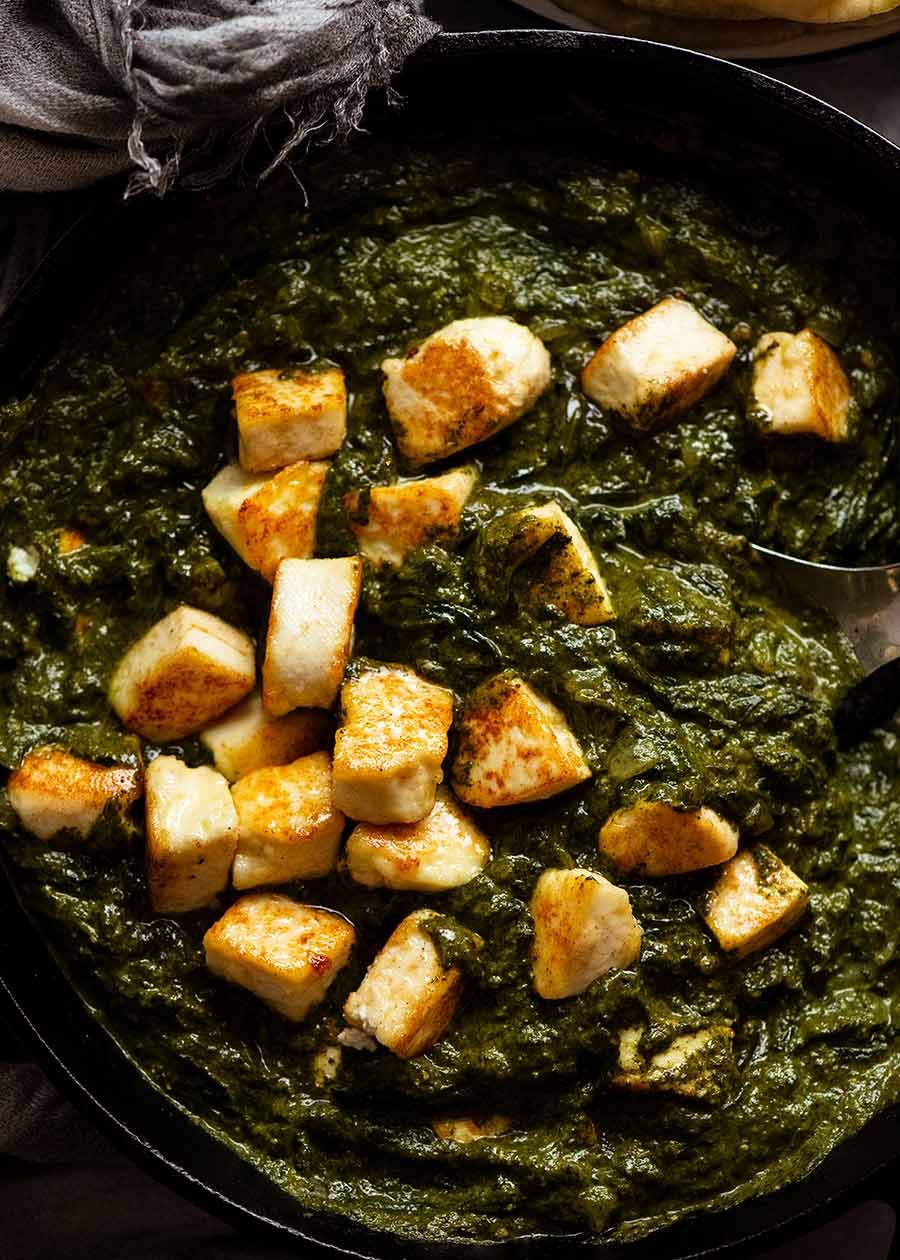
Palak Paneer – spinach curry -
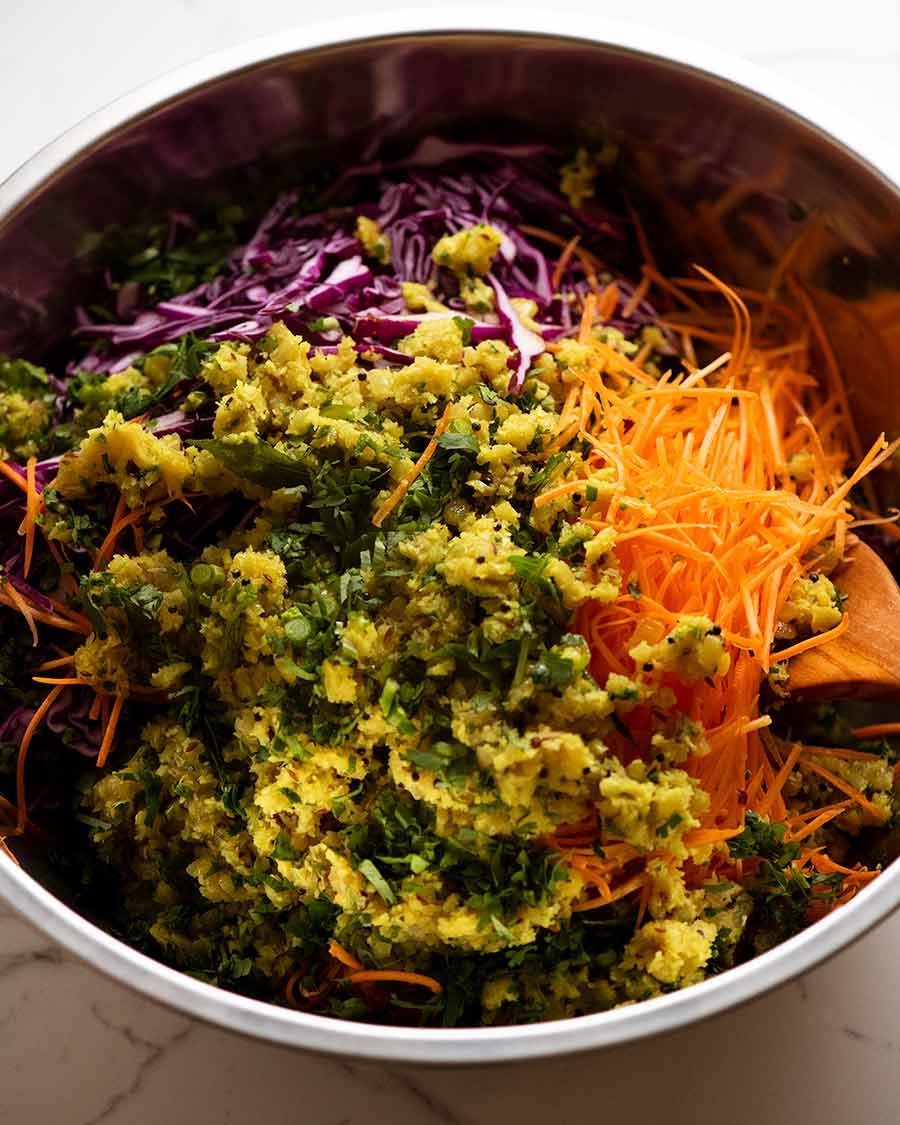
Thoran-style Indian Cabbage Salad
Samosa recipe
If you think of an “Indian snack”, probably the first image that pops into mind is the humble Samosa.
These little fried parcels of flaky-yet-tender pastry, stuffed to the brim with spiced potatoes and other ingredients, are pretty much my idea of the world’s greatest savoury snack.
Not only are they insanely delicious, but they’re also incredibly versatile. Samosas can be served as appetisers, entrees, or a lunch on the move. They’re good hot or at room temperature. They keep for days and days, and they reheat well. What is not to love?!?
Finding a great Samosa though, is no easy feat – whether they’re bought or recipes. Most are “OK” but never quite get there for me. So I set myself the (not-insignificant!) challenge of creating my own ideal Samosa recipe.
And so, after many rounds of testing, eating, rethinking and (yes!) eating some more, I’m happy to report I’ve finally arrived at this recipe – my idea of the perfect Samosa!
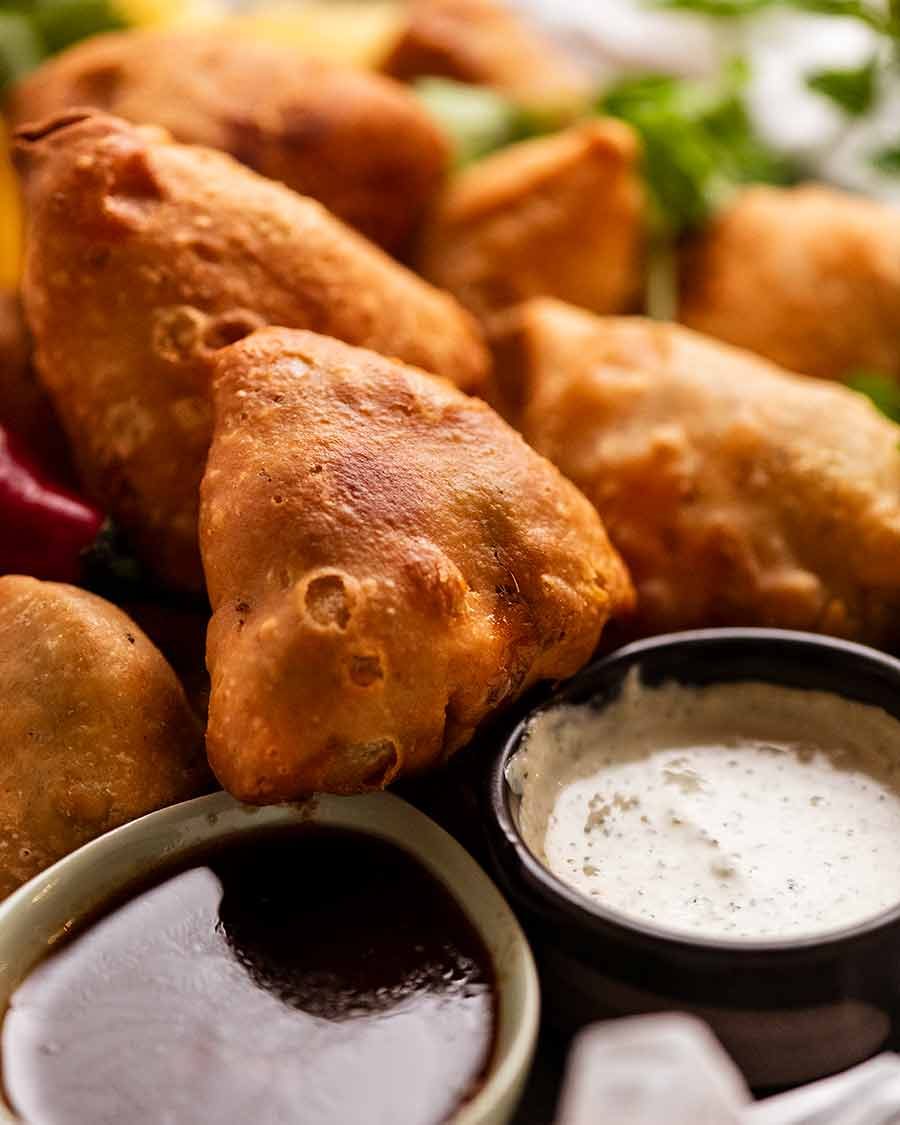
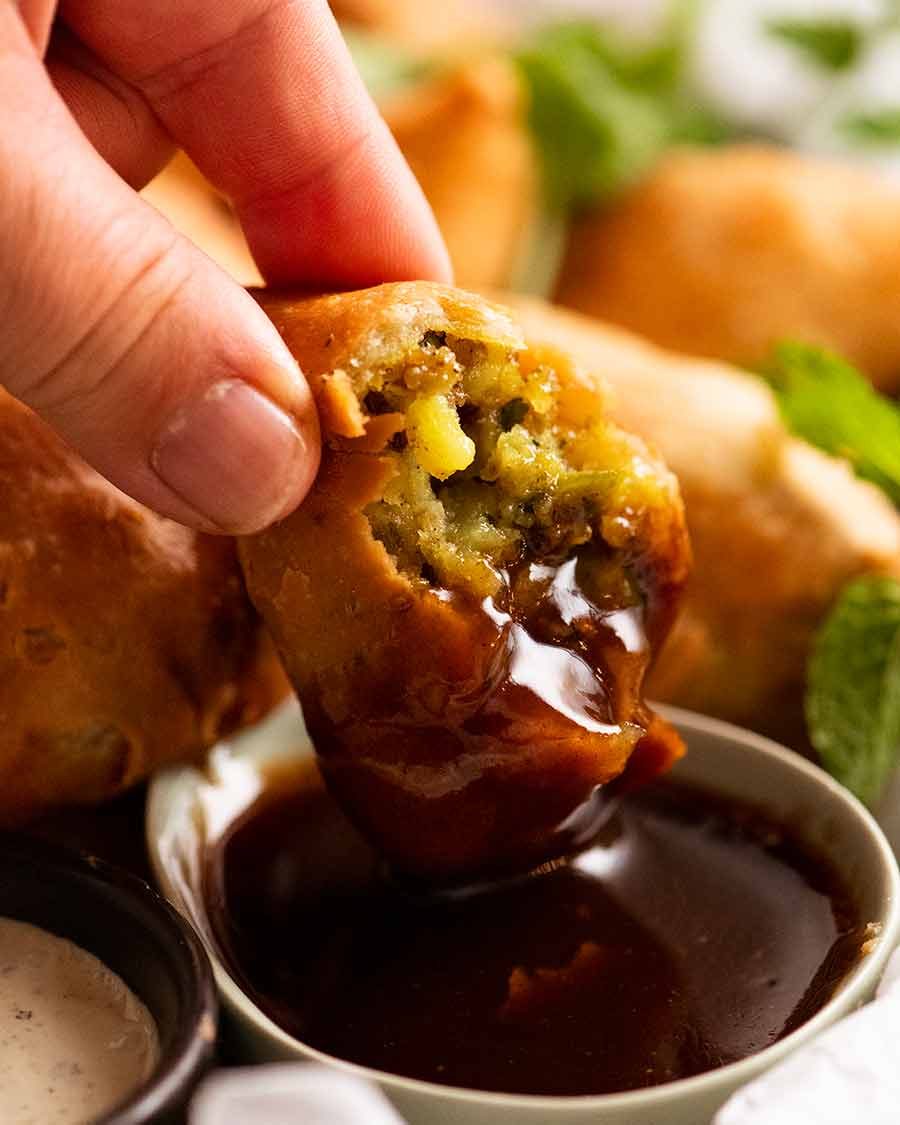
What you need to make Samosas
Here’s what you need to make Samosas. Yes, you will see a few less-common spices in this recipe that call for a trip to the Indian grocery store if you truly want to make real Samosas. If not, I’ve got alternatives to suggest!
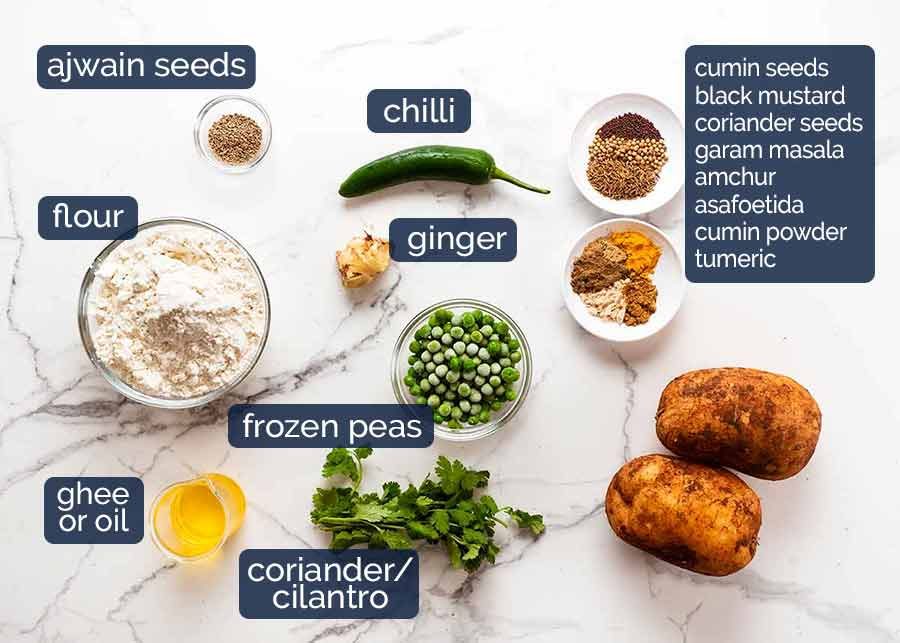
The spices
The spices marked with an asterisk* are speciality spices that likely require a trip to an Indian grocery store. But I’ve made notes for best substitutions!
-
Ajwain seeds* – An Indian spice with a fragrant and fruity but bitter taste. Substitute thyme leaves;
-
Amchur* – Also known as mango powder, is made from dried green mangoes. It is sour in taste and is said to help digestion. Substitute 1/2 tsp lemon juice;
-
Asafoetida* – Also known as hing, this is a traditional ingredient used in Indian cooking that is derived from a species of giant fennel. It has a somewhat bitter garlic / onion flavour, which makes it a great substitute for people who can’t have garlic or onion.! Substitute 1/4 tsp each of garlic and onion powder;
-
Black mustard seeds – They look like poppyseeds but are fragrant and have a slight horseradish-like bite to them. They’re not spicy, more a fresh zing. ~ $1.50 in small packs at Indian grocery stores. Also sold in the Indian food section at some Woolworths (Australia) $1.70, and online! Also used in Eggplant Curry, Dal and Vegetable Samosa Pie recipes;
-
Garam Masala – A well-known Indian spice mix which is pretty common these days. It’s found in the spice aisle of regular supermarkets and costs not more than other spices; and
-
Cumin seeds and powder, coriander seeds and turmeric – Very common spices used in Indian cooking, found everywhere these days at regular grocery stores.
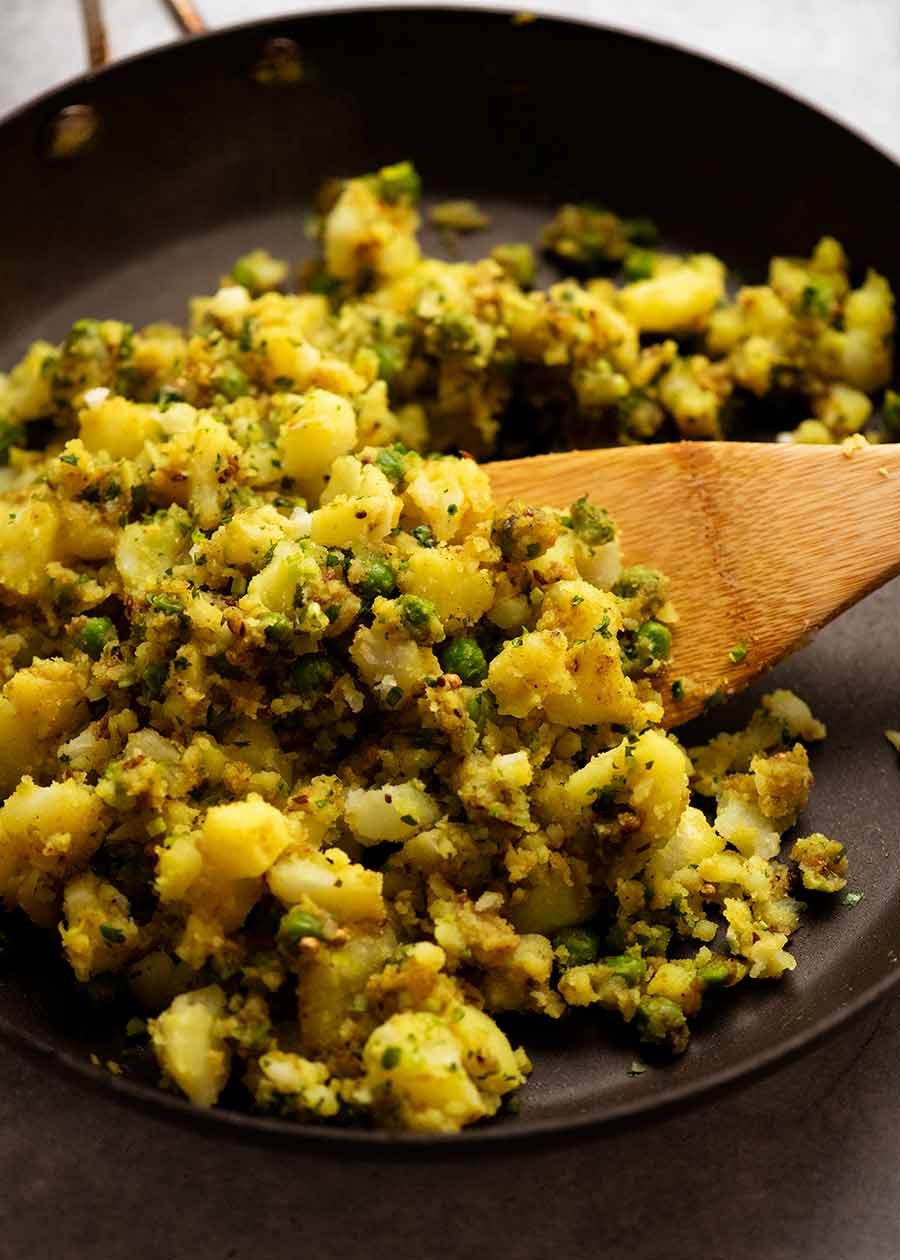
Other ingredients
-
Flour – Just regular all purpose/plain flour;
-
Green chilli – Use a cayenne pepper which provides just a mild background hum of spice. These Samosas are not overly spicy!
-
Ghee or oil – Ghee is a traditional cooking fat used in Indian cooking. It is simply normal butter but with milk solids and water removed, leaving behind pure butter fat. Ghee has a more intense butter flavour than normal butter, with the added bonus that unlike butter, it doesn’t burn even on high heat.
It is rubbed into the flour to make the Samosa pastry flaky.
You can either make your own Ghee (it’s cheaper, really easy and keeps for months), buy it, or just use normal butter;
-
Potatoes – For the potato filling. Use either starchy or all-rounder potatoes, such as Sebago (Australia brushed “dirt” potatoes), Russet, Yukon Gold or Idahos (US), Maris Piper or King Edwards (UK);
-
Ginger – Fresh ginger is best here, but you could substitute with ginger powder in an emergency 😇;
-
Peas – Frozen all the way! No need for fresh here; and
-
Coriander/cilantro – Stirred into the potato filling at the end, it adds such a great hit of freshness.
How to make Samosas
The four parts to making Samosas are:
-
The spiced potato filling;
-
The Samosa dough;
-
Making the Samosa parcels; and
-
Frying – Sorry, there is no alternative! Do not try to bake them, you will be sorely disappointed!
Part 1: Spiced potato filling
The filling for Samosas is typically vegetarian, made with roughly mashed potato that’s cooked up with spices, fresh green chilli and peas. Altthough you’ll see plenty of versions with meat (usually ground), I like to keep things traditional – regular readers know I don’t say that often!😂
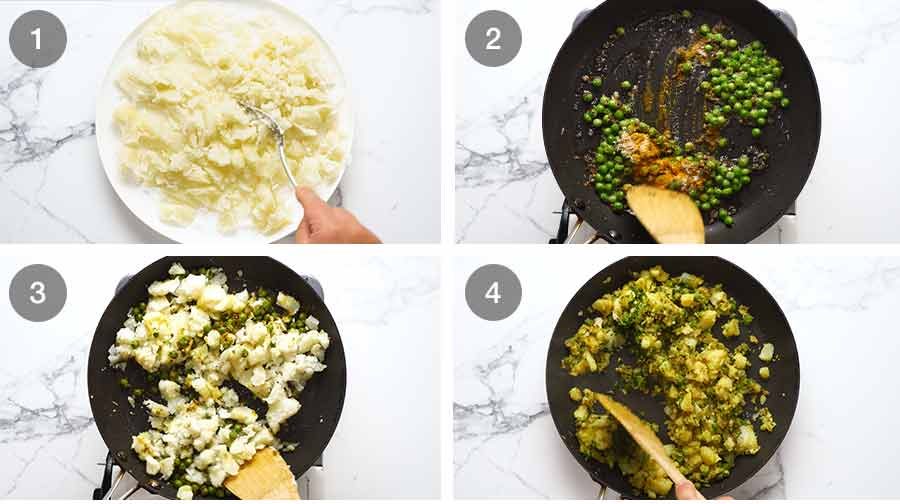
-
Rough-mashed potato – Boil potatoes until tender, then use a fork to roughly mash. It’s nice to have bits of chunks in the potato for interest, rather than a soft, creamy and uniform mash;
-
Cook spices and aromatics – A healthy dose of spices are fried up with fresh ginger and chilli which is then tossed through along the peas;
-
Add potato – Add the mashed potato and gently but thoroughly mix through, so the flavouring fully permeates the potato; and
-
Fresh coriander, then cool – Lastly, mix through fresh coriander, then let the filling cool completely before using.
Part 2: Samosa dough
A key feature of the Samosa pastry is how flaky it is. This is achieved by rubbing ghee or oil into the flour until it resembles breadcrumbs, just like we do with Western shortcrust pastry!
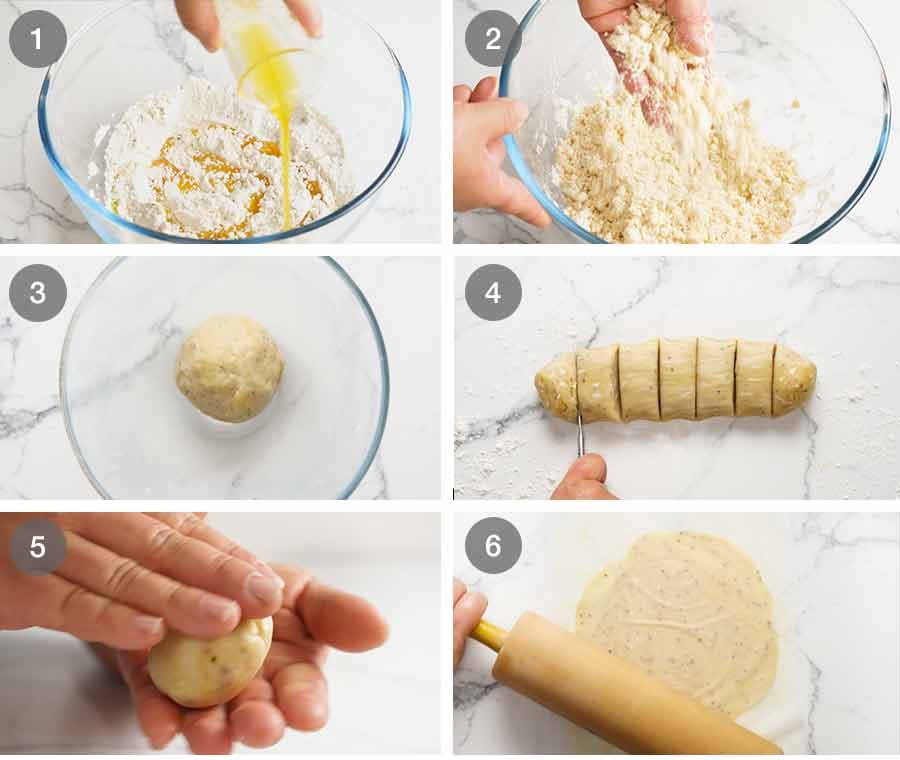
-
Mix dry ingredients, add ghee – Mix the flour, Ajwain seeds and salt, then pour the ghee or oil in;
-
Rub fat in – Use your fingers to rub the ghee in until it resembles coarse breadcrumbs. This is the step that gives the Samosa pastry the signature flakiness we know and love so much!
-
Form dough, rest 30 minutes – We then add water until it is wet enough to form a dough. The dough should be soft and pliable, but not so sticky that it sticks to your hands. Form a ball and let it rest for 30 minutes;
-
Divide – Form a log, then cut into 6 equal pieces;
-
Shape dough into balls;
-
Roll out balls to 2mm thick – Roll the dough balls into discs 2mm thick. They should be about 16cm /6.5” in diameter.
Now, you’re ready to make the little Samosa parcels!
Part 3: Samosa parcels
Don’t get stressed out about this part. It’s honestly not that hard. And if yours are a bit deformed and wonky, so what? It’s still going to taste amazing!!! And you can just say they’re “rustic”. 😉
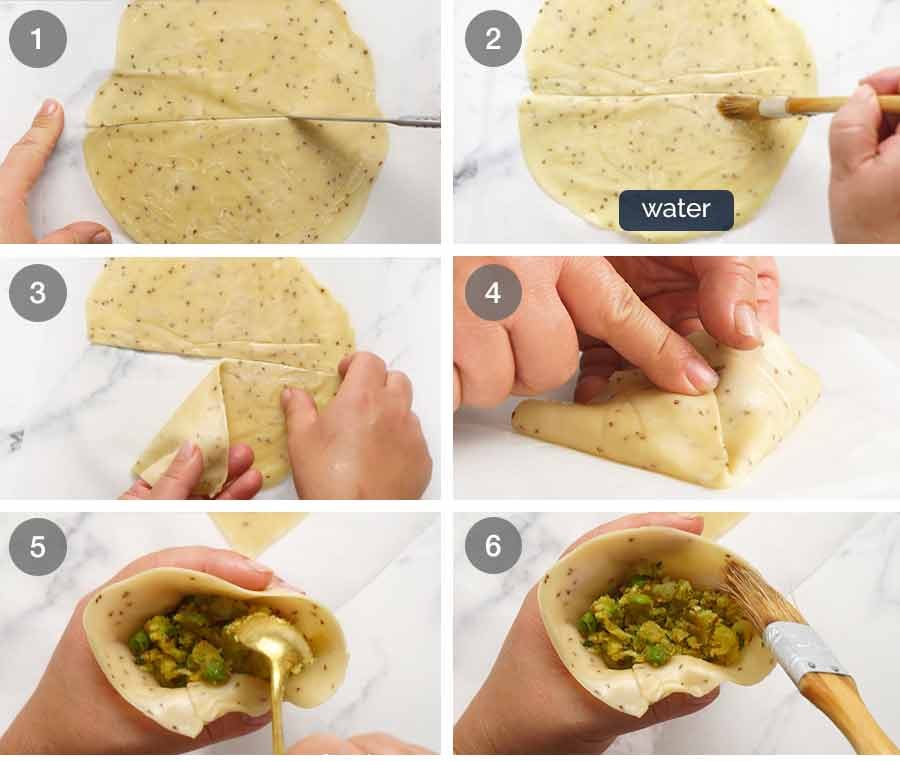
-
Cut in half – Use a small knife to cut a circle in half. Work with one disc of dough at a time. Keep the others covered under cling wrap so they don’t dry out;
-
Brush disc with water along half the straight edge you just cut;
-
Fold one side in;
-
Form cone – Then fold the other side in, overlapping by about 1cm / 2/5″, to form a cone shape. Press joined edges together to secure;
-
Fill cone – Form an “O” with your thumb and forefinger, then place the cone inside (like at the holders at the ice cream shop). Fill with the spiced potato filling;
-
Brush with water along the cone mouth edge;
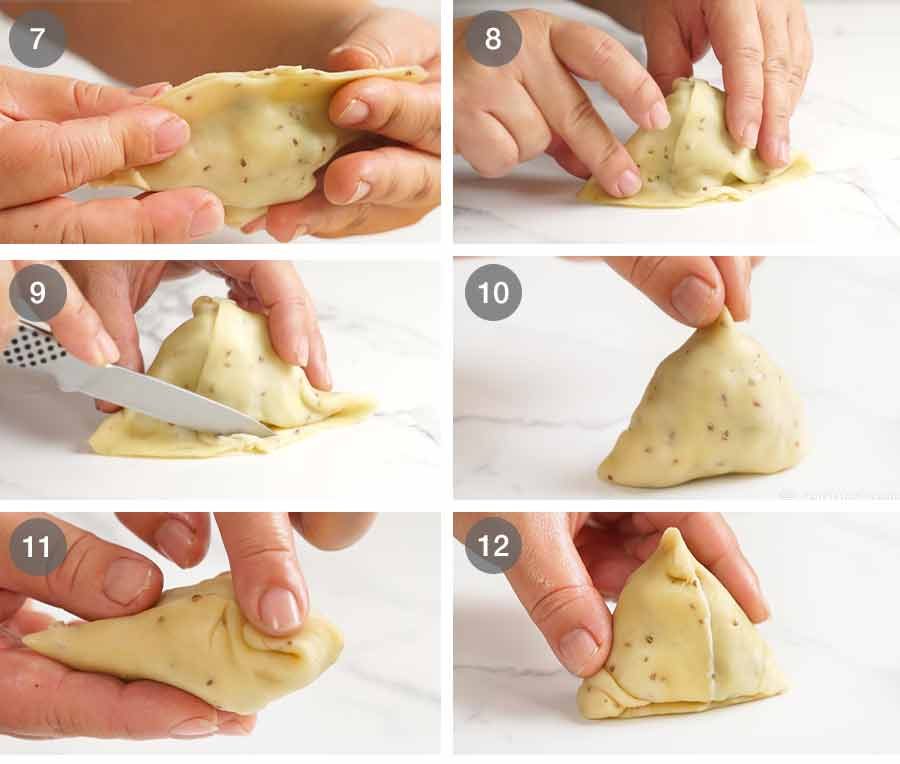
-
Seal – Press to seal;
-
Fold seam side down – Place the seam side down on the work surface so it folds over;
-
Trim excess pastry off;
-
Pinch top of cone to make it nice and pointy;
-
Fold in the other two corners;
-
Voila! You’re done!
Part 4: Frying – and the trick to less greasy, ultra-crispy Samosas!
The trick to frying Samosas is to start on low heat, otherwise the pastry can burst open and the filling spills out into the hot oil!
Consequently, most recipes will call for the Samosas to be fried at a relatively low temperature of 160°C/320°F for 10 minutes+. But this makes them SUPER-greasy!
Instead, we’re using the good old, reliable Asian double-fry method. It’s fast becoming the world’s worst-kept cooking secret for less greasy, ultra-crispy fried goods, it’s used in takeout favourites from Honey Chicken to Sweet & Sour Pork, to Japanese Karaage. It involves an initial fry on low heat to seal, followed by a second fry on high heat to colour and crisp.
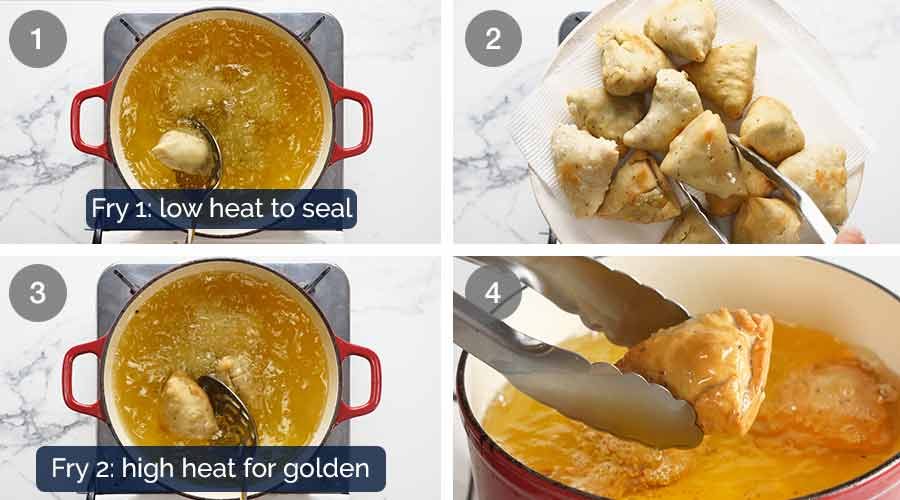
-
First fry: Seal Pastry – Heat the oil to 160°C/320°F, then fry 3 or 4 samosas for 3 minutes, turning occasionally. The pastry should be cooked but pale;
-
Drain on paper towels then repeat this first fry with remaining samosas;
-
Second fry: Colour and crisp – Once you’ve done the first fry with all the Samosas, increase the oil heat to 190°C/375°F. Then fry the Samosas in batches of 3 or 4 for around 1 1/2 to 2 minutes until golden. The Samosas are already cooked through, this step is just to colour and really crisp up that pastry;
-
Drain on paper towels and serve piping hot for optimum eating experience!
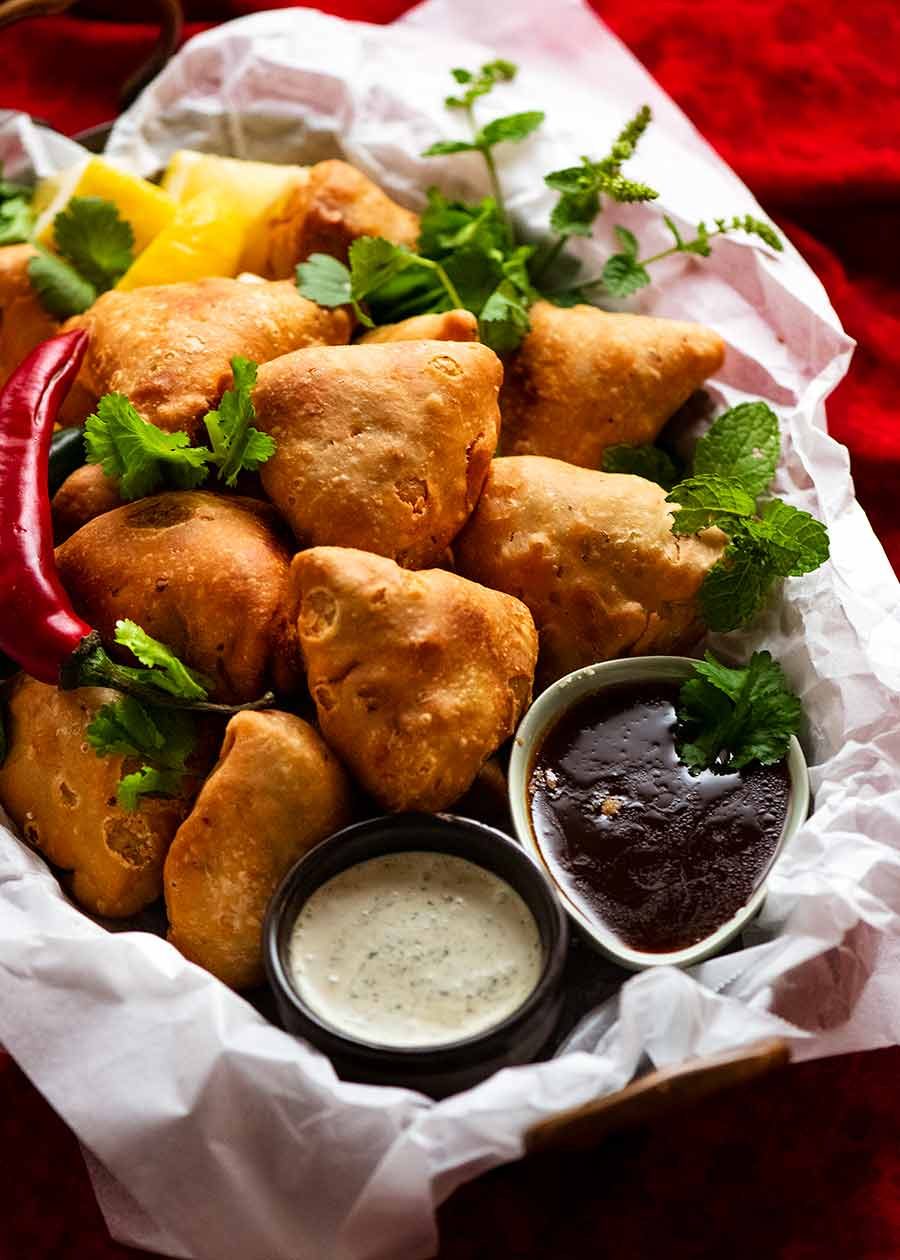
Dipping Sauce for Samosas
The recipe includes a Tamarind Dipping Sauce which is a popular condiment to serve alongside Samosas. The sauce is a bit tart, which nicely cuts through the rich flaky pastry and balances the spice infused filling.
For a simpler option, you could just blitz up yogurt with fresh mint leaves for a quick Raita of sorts (Indian Mint Sauce).
How to serve Samosas
Samosas, like Pakoras, are typically served as a starter or snack, being the terrific hand-held size that they are. Though mind you, I’ve seen plenty of gigantic Samosas in my time. I can’t deal with the thought of the volume of oil required to fry those beasts! 😂
I’m sharing this Samosa recipe as part of an Indian Week, so you can make your very own Indian feast! Just to recap, here’s what we’ve got on the menu:
-
Palak Paneer – The iconic Indian Spinach Curry with your very own homemade cheese curd (puts store bought to shame!);
-
Naan – The softest, fluffiest, chewiest naan you will ever make!
-
Indian Cabbage Salad – This one will surprise you, it’s so incredibly delicious; and
-
Samosas – to kick start your party!
And with this Samosa recipe, that’s a wrap on Indian Week. I hope you’ve enjoyed the recipes as much as I have creating them … oh yes, and shooting them and filming them and making them over and over to check them … and DEVOURING them!! 😂 – Nagi x
Watch how to make it
Hungry for more? Subscribe to my newsletter and follow along on Facebook, Pinterest and Instagram for all of the latest updates.
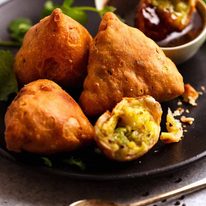
Samosa Recipe
#wprm-recipe-rating-0 .wprm-rating-star.wprm-rating-star-full svg * { fill: #343434; }#wprm-recipe-rating-0 .wprm-rating-star.wprm-rating-star-33 svg * { fill: url(#wprm-recipe-rating-0-33); }#wprm-recipe-rating-0 .wprm-rating-star.wprm-rating-star-50 svg * { fill: url(#wprm-recipe-rating-0-50); }#wprm-recipe-rating-0 .wprm-rating-star.wprm-rating-star-66 svg * { fill: url(#wprm-recipe-rating-0-66); }linearGradient#wprm-recipe-rating-0-33 stop { stop-color: #343434; }linearGradient#wprm-recipe-rating-0-50 stop { stop-color: #343434; }linearGradient#wprm-recipe-rating-0-66 stop { stop-color: #343434; }
Ingredients
Dough:
- 1 1/2cupsflour, plain/all purpose
- 1tspajwain seeds(Note 1)
- 1/2tspsalt, cooking/kosher
- 4tbspghee(melted and cooled) or oil (any vegetable) (Note 2)
- 6tbspwater(cold tap water)
Potato Filling:
- 500g/1potatoes, starchy/all-rounder (Note 3)
- 2tbspvegetable/canola oil
- 1tspcumin seeds
- 1/4tspblack mustard seeds
- 1/2tspcoriander seeds
- 1tbspfresh ginger, finely grated
- 1tbspgreen chilli, finely chopped (serrano or cayenne)
- 1/2cupfrozen green peas(thawed)
- 1tspgaram masala
- 1/4tspamchur(Note 4)
- 1/2tspasafoetida(Note 5)
- 1/4tspcumin powder
- 1/2tspturmeric powder
- 1tspsalt, kosher/cooking
- 2tbspcoriander/cilantro leaves, finely chopped
Frying:
- Vegetable/Canola oil for frying(at least 1 litre/1 quart)
Serving:
- Tamarind Dipping Sauce– see separate recipe card below
Instructions
Potato Filling:
-
Boil potato until soft: Peel then cut potatoes in half. Place in a pot of cold water, bring to boil then cook until very soft, ~10 minutes.
-
Mash roughly: Remove the potatoes onto a plate and roughly mash with a fork, leaving some large chunks (we want some textural interest).
-
Cook spice seeds: Heat oil in a large skillet over medium heat. Add the cumin seeds, mustard seeds & coriander seeds. Stir the spices for about 30 seconds or until fragrant – don’t let them burn!
-
Add the ginger, chilli, peas and continue to stir a further minute or so until the chilli is soft.
-
Add remaining spices: Add the garam masala, amchur, asafoetida, cumin powder, turmeric and salt. Cook a further 30 seconds.
-
Add potato and gently stir to coat in spices for about 1 minute.
-
Cool: Remove from the stove, stir in chopped coriander leaves. Spread potato mixture out on a plate and let it cool completely before using.
Samosa Dough:
-
Mix dry ingredients: Place the flour, salt and ajwain seeds into a bowl and stir to combine.
-
Rub ghee into flour: Add the ghee or oil and mix with your fingertips until the dough resembles breadcrumbs. (This step is key to making flaky samosa pastry.)
-
Form a ball: Add the water and mix with the flour until you form a ball of dough. It should be pliable and soft, but not so sticky it sticks to your hands,.
-
Rest 30 minutes: Cover the dough in the bowl with glad wrap and leave to rest for 30 minutes.
Making the Samosas – see video:
-
Cut into 6: Cut the dough into 6 equal portions, then roll each into a ball. Keep the balls on a plate covered with cling wrap so they don’t dry out.
-
Place between paper: Place one ball on a sheet of parchment/baking paper. Press down to flatten, then cover with another sheet of paper. Do not flour the work surface – it will dry the pastry out.
-
Roll out: Roll the dough into a disc about 2mm / 1/10″ thick (~16cm /6.5” diameter).
-
Cut in half: Cut through the centre to create two semicircles (2 samosas per disc).
-
Make cone: Brush the straight side with water, then fold straight edge to join itself and form a cone. Overlap the edges by about 1 cm / 2/5″ then press edges to seal.
-
Fill with potato: Make an “O” with your forefinger and thumb, then hold the cone in the “O”. Fill with about 2 tbsp of Potato Mixture, lightly pressing in.
-
Seal: Brush the open pastry edge with water, then press together so your Samosa is fully sealed. Place sealed edge down on work surface and press down to fold. Trim off excess pastry, fold in corners. Pinch the top corner to make it pointy.
-
Repeat with remaining Samosas – you should make 12 in total.
Frying:
-
Heat oil to medium: In a deep pan or pot, heat 5cm / 2″ oil to 160°C/320°F). (Note 7)
-
Fry 1: Carefully drop 3 – 4 samosas in the oil and cook for 3 minutes, moving them around occasionally (if they touch the base of the pot for too long, they get brown spots).
-
Drain and repeat: Remove from the oil and drain on paper towels. Repeat with the remaining samosas.
-
Increase oil heat: Increase the oil temperature up to 190°C/375°F.
-
Fry 2: Carefully place 3 – 4 samosas at the time into the oil, and cook for 1 1/2 to 2 minutes until they are deep golden. Remove from the oil and drain on paper towels. Repeat with remaining Samosas.
-
Serve hot with Tamarind Sauce or a Mint Raita (see separate recipe card below this one)
Recipe Notes:
Nutrition Information:
Hungry for more? Subscribe to my newsletter and follow along on Facebook, Pinterest and Instagram for all of the latest updates.

Tamarind Dipping Sauce for Samosas
#wprm-recipe-rating-1 .wprm-rating-star.wprm-rating-star-full svg * { fill: #343434; }#wprm-recipe-rating-1 .wprm-rating-star.wprm-rating-star-33 svg * { fill: url(#wprm-recipe-rating-1-33); }#wprm-recipe-rating-1 .wprm-rating-star.wprm-rating-star-50 svg * { fill: url(#wprm-recipe-rating-1-50); }#wprm-recipe-rating-1 .wprm-rating-star.wprm-rating-star-66 svg * { fill: url(#wprm-recipe-rating-1-66); }linearGradient#wprm-recipe-rating-1-33 stop { stop-color: #343434; }linearGradient#wprm-recipe-rating-1-50 stop { stop-color: #343434; }linearGradient#wprm-recipe-rating-1-66 stop { stop-color: #343434; }
Ingredients
- 1tbspvegetable/canola oil
- 1/2tspground ginger
- 1/4tspchilli powder*optional
- 1/2tspground cumin
- 1/4tspasafoetida(Note 1)
- 1/4tspgaram masala
- 1cupwater
- 2 – 3tbsptamarind paste/concentrate(Note 2)
- 1/2cupbrown sugar
Instructions
-
Heat the oil in a small saucepan over medium heat.
-
Add the ginger, chilli, cumin, asafoetida and garam masala, stir and cook gently for 1 minute to release the flavours and toast the spices.
-
Add the water, tamarind paste and brown sugar and stir until the sugar has completely dissolved.
-
Reduce the heat and simmer gently for 15 minutes until the sauce turns thick and syrupy – it should be the consistency of sweet soy/ketchup manis (ie. like very runny honey). Taste and adjust the tamarind to suit.
-
Cool the sauce before using. The sauce will thicken as it cools.
-
Serve with hot Samosas.
Nutrition Information:
Life of Dozer
Most people look for a pot of gold at the foot of a rainbow. Dozer is just thinking – “snacks?!

